10.10.2020

The complex history of asteroid Bennu
OSIRIS-REx sends back enough data for six studies.

The more scientists learn about near-Earth asteroid Bennu, now being orbited by NASA’s OSIRIS-REx spacecraft, the more it appears that NASA chose well when it picked it as the mission’s target.
Previous research had found Bennu to be a “rubble pile” of rocks assembled from the breakup of a larger body. Many of these rocks appear to be rich in hydrated minerals, a sign that its parent body was rich in water.
Now, scientists are also finding signs that the asteroid is rich in carbon, including minerals that must have formed in hydrothermal systems beneath the surface of the parent asteroid.
That means that it not only had carbon, but was hot enough to have liquid water, says Hannah Kaplan, a spectroscopist at NASA Goddard Space Flight Center, and first author of one of six papers describing the latest findings in the journals Science and Science Advances.
Not that the water was on the surface. “We are talking about something occurring in the interior of the body,” she says.
The telltale minerals, Kaplan says, are carbonates, which her team discovered by looking for their spectroscopic features in close-up images of Bennu’s surface. “I found places where I was quite convinced that this was carbonate,” she says.
At the same time, other scientists were noticing bright streaks in high-resolution images of some of the asteroid’s boulders that appear to be veins of carbonates, up to a metre long and several centimetres wide.
These veins, Kaplan says, appear to be relics of the parent body’s internal plumbing, now broken up, jumbled together, and visible on Bennu. They also appear to date from very early in Solar System history, when the parent body had enough internal heating from short-lived radioisotopes to still be hot enough for hydrothermal systems to form.
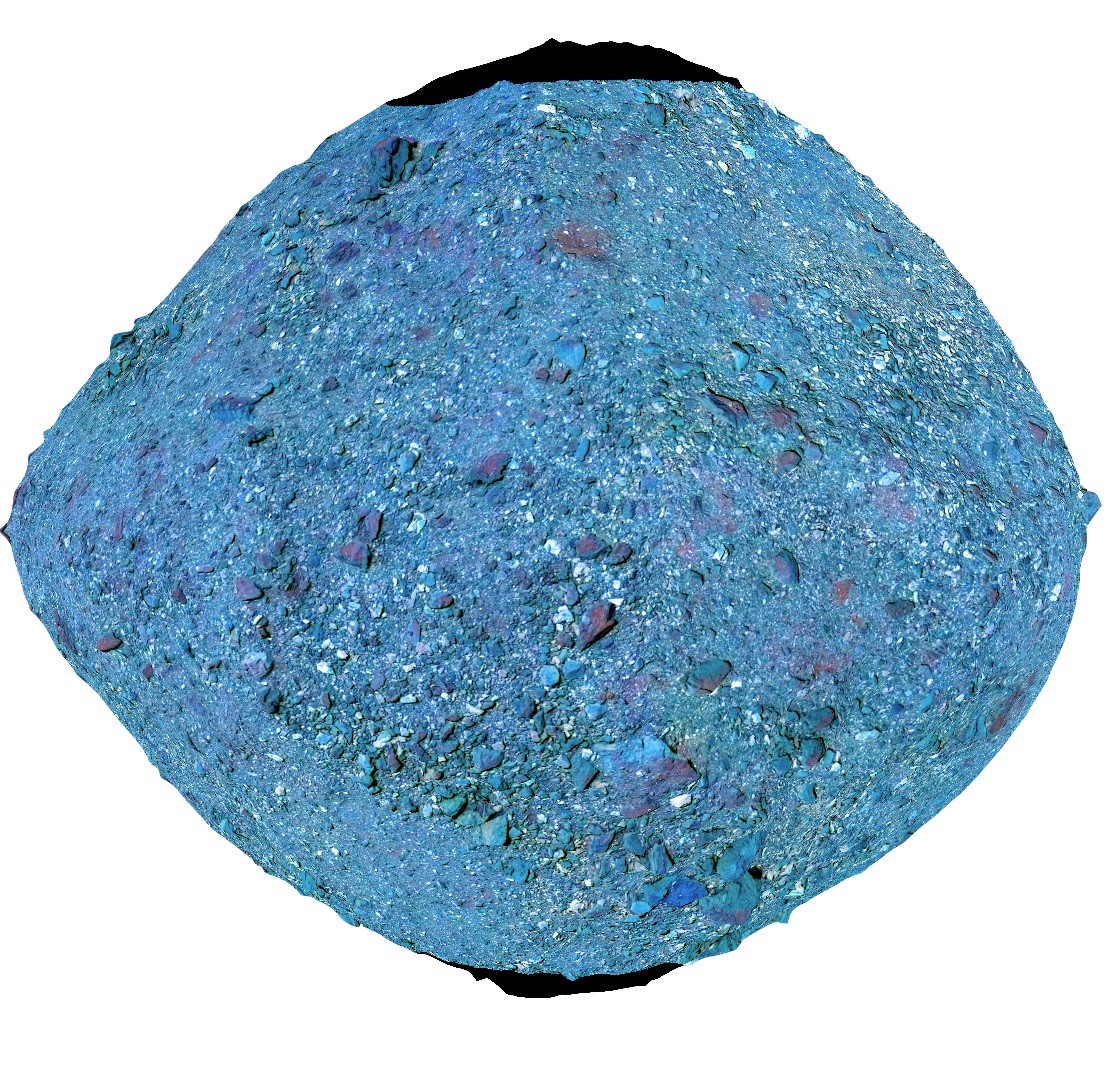
Nor are carbonate minerals the only carbon-bearing materials scientists are seeing on Bennu. There are also organic materials, discovered from the spectroscopic signature of their carbon-hydrogen bonds, says Amy Simon, a planetary scientist also at NASA Goddard, and first author of another of the new papers.
What exactly these materials are is uncertain, but Kaplan notes that a lot of meteorites collected on Earth are rich in what she calls “organic gunk”. You can extract it from them and get a solid dark substance, somewhat like asphaltite, a naturally occurring mineral akin to asphalt, she says.
This is important because asteroids are thought to be a possible source for the Earth’s organic materials, including important precursors to life, such as amino acids.
OSIRIS-REx’s primary mission is to return a sample of the asteroid to Earth for study in the world’s finest laboratories, so finding such materials on Bennu could be extremely useful to understanding how our planet became habitable.
And happily, says Simon, these materials appear to be scattered all across Bennu’s surface, rather than clustered in small areas.
That means anywhere OSIRIS-REx can safely land to pick up a sample is likely to be a good site, without mission controllers having to choose between getting the materials scientists want and risking an excessively dangerous landing.
Another study in the new set of papers found that Bennu’s boulders behave unusually as they cool when Bennu’s rotation cycles them from day into night.
Oddly, says Humberto Campins, a planetary scientist at the University of Central Florida, Orlando, who was a co-author on three of the new papers, the largest boulder on Bennu’s surface appears to respond to this daily heating and cooling more like beach sand than a normal boulder.
On Earth, he says, if you were to go to the beach shortly after sunset and lean against a big rock, you would find it to be pleasantly warm while the sand is cool – a hallmark of the difference between the rates at which small particles and large rocks warm and cool. “[But] on Bennu,” he says, “the biggest rock behaves like loose sand, and the smaller [ones] behave like rocks.”
Why is an open question. “Maybe the big ones are porous and the small ones are more compact,” he says. “The point is the thermal behaviour is different from what we expected.”
All told, he says, Bennu is proving to be a treasure trove of information. Though, he adds, “of course, we will know more when we bring back that sample”.
And that while that sample can’t get back to Earth before 2023, collecting it is the next goal, planned for later this month, on 20 October.
If it works, expect a big cheer from mission control. If not, NASA has backup plans to attempt as many as three sample-collection efforts.
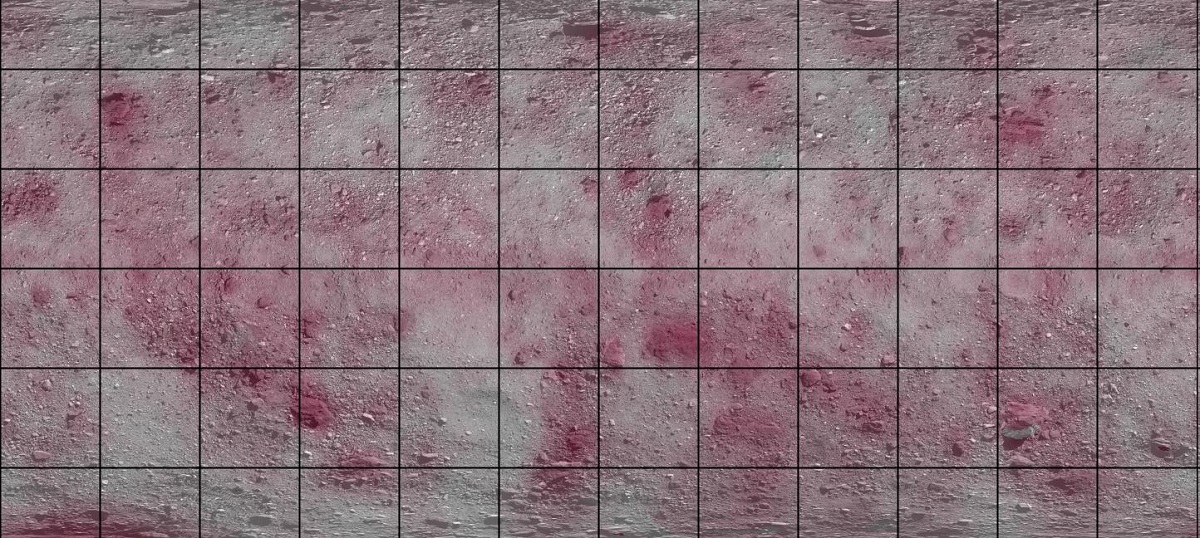
Quelle: COSMOS
+++
Scientists peer inside an asteroid

Banner image: Artist's depiction of the OSIRIS-REx spacecraft swooping toward the asteroid Bennu to collect a sample of material from its surface. (Credit: NASA/Goddard/University of Arizona)
New findings from NASA’s OSIRIS-REx mission suggest that the interior of the asteroid Bennu could be weaker and less dense than its outer layers—like a crème-filled chocolate egg flying though space.
The results appear in a study published today in the journal Science Advances and led by the University of Colorado Boulder’s OSIRIS-REx team, including professors Daniel Scheeres and Jay McMahon. The findings could give scientists new insights into the evolution of the solar system’s asteroids—how bodies like Bennu transform over millions of years or more.
OSIRIS-REx rendezvoused with Bennu, an asteroid orbiting the sun more than 200 million miles from Earth, in late 2018. Since then, the spacecraft, built by Colorado-based Lockheed Martin, has studied the object in more detail than any other asteroid in the history of space exploration.
So far, however, one question has remained elusive: What’s Bennu like on the inside?
Scheeres, McMahon and their colleagues on the mission’s radio science team now think that they have an answer—or at least part of one. Using OSIRIS-REx’s own navigational instruments and other tools, the group spent nearly two years mapping out the ebbs and flows of Bennu’s gravity field. Think of it like taking an X-ray of a chunk of space debris with an average width about the height of the Empire State Building.
“If you can measure the gravity field with enough precision, that places hard constraints on where the mass is located, even if you can’t see it directly,” said Andrew French, a coauthor of the new study and a former graduate student at CU Boulder, now at NASA’s Jet Propulsion Laboratory (JPL).
What the team has found may also spell trouble for Bennu. The asteroid’s core appears to be weaker than its exterior, a fact that could put its survival at risk in the not-too-distant future.
“You could imagine maybe in a million years or less the whole thing flying apart,” said Scheeres, a distinguished professor in the Ann and H.J. Smead Department of Aerospace Engineering Sciences.
Evolution of asteroids
Of course, that’s part of the fun of studying asteroids. Scheeres explained that Bennu belongs to a class of smaller bodies that scientists call “rubble pile” asteroids—which, as their name suggests, resemble loosely held-together mounds of debris.
Asteroids also change over time more than people think.
“None of them have sat out there unchanging since the dawn of the solar system,” Scheeres said. “They’re being changed by things like sunlight affecting how they spin and collisions with other asteroids.”
To study how Bennu and other similar asteroids may change, however, he and his colleagues needed to take a peek inside.
This is where the team got lucky. When OSIRIS-REx first arrived at Bennu, the spacecraft spotted something unusual: Over and over again, tiny bits of material, some just the size of marbles, seemed to pop off the asteroid and into space. In many cases, those particles circled Bennu before falling back down to the surface. Members of the mission’s radio science team at JPL were able to witness how the body’s gravity worked first-hand—a bit like the apocryphal story of Isaac Newton inferring the existence of gravity after observing an apple falling on his head.
“It was a little like someone was on the surface of the asteroid and throwing these marbles up so they could be tracked,” Scheeres said. “Our colleagues could infer the gravity field in the trajectories those particles took.”
Squishy center
In the new study, Scheeres and his colleagues combined those records of Bennu’s gravity at work with data from OSIRIS-REx itself—precise measurements of how the asteroid tugged on the spacecraft over a period of months. They discovered something surprising: Before the mission began, many scientists had assumed that Bennu would have a homogenous interior. As Scheeres put it, “a pile of rocks is a pile of rocks.”
But the gravity field measurements suggested something different. To explain those patterns, certain chunks of Bennu’s interior would likely need to be more tightly packed together than others. And some of the least dense spots in the asteroid seemed to lie around the distinct bulge at its equator and at its very core.
“It’s as if there is a void at its center, within which you could fit a couple of football fields,” Scheeres said.
The asteroid’s spin may be responsible for that void. Scientists know that the asteroid is spinning faster and faster over time. That building momentum could, Scheeres said, be slowly pushing material away from the asteroid’s center and toward its surface. Bennu, in other words, may be in the process of spinning itself into pieces.
“If its core has a low density, it’s going to be easier to pull the entire asteroid apart,” Scheeres said.
For the scientist, the new findings are bittersweet: After measuring Bennu’s gravity field, Scheeres and his team have mostly wrapped up their work on the OSIRIS-REx mission.
Their results have contributed to the mission’s sample analysis plan—currently in development. The returned sample will be analyzed to determine the cohesion between grains—a key physical property that affects the mass distribution observed in their study.
“We were hoping to find out what happened to this asteroid over time, which can give us better insight into how all of these small asteroids are changing over millions, hundreds of millions or even billions of years,” Scheeres said. “Our findings exceeded our expectations.”
The University of Arizona leads science operations for OSIRIS-REx. NASA’s Goddard Space Flight Center in Maryland manages the overall mission.
Other coauthors on the new study include researchers at the Jet Propulsion Laboratory, Smithsonian Institution, The Open University, Northern Arizona University, KinetX Aerospace, Inc., NASA Goddard Space Flight Center, University of Maryland, Johns Hopkins University, York University, University of British Columbia, Southwest Research Institute, Université Côte d’Azur and University of Arizona.
Quelle: University of Colorado Boulder
+++
NASA’s first asteroid sample return mission now knows much more about the material it’ll be collecting in just a few weeks. In a special collection of six papers published today in the journals Science and Science Advances, scientists on the OSIRIS-REx mission present new findings on asteroid Bennu’s surface material, geological characteristics, and dynamic history. They also suspect that the delivered sample of Bennu may be unlike anything we have in the meteorite collection on Earth.
These discoveries complete the OSIRIS-REx mission’s pre–sample collection science requirements and offer insight into the sample of Bennu that scientists will study for generations to come.
One of the papers, led by Amy Simon from NASA’s Goddard Space Flight Center in Greenbelt, Maryland, shows that carbon-bearing, organic material is widespread on the asteroid’s surface, including at the mission’s primary sample site, Nightingale, where OSIRIS-REx will make its first sample collection attempt on October 20. These findings indicate that hydrated minerals and organic material will likely be present in the collected sample.
This organic matter may contain carbon in a form often found in biology or in compounds associated with biology. Scientists are planning detailed experiments on these organic molecules and expect that the returned sample will help answer complex questions about the origins of water and life on Earth.
“The abundance of carbon-bearing material is a major scientific triumph for the mission. We are now optimistic that we will collect and return a sample with organic material – a central goal of the OSIRIS-REx mission,” said Dante Lauretta, OSIRIS-REx principal investigator at the University of Arizona in Tucson.
Authors of the special collection have also determined that carbonate minerals make up some of the asteroid’s geological features. Carbonate minerals often precipitate from hydrothermal systems that contain both water and carbon dioxide. A number of Bennu’s boulders have bright veins that appear to be made of carbonate – some of which are located near the Nightingale crater, meaning that carbonates might be present in the returned sample.
The study of the carbonates found on Bennu was led by Hannah Kaplan, from Goddard. These findings have allowed scientists to theorize that Bennu’s parent asteroid likely had an extensive hydrothermal system, where water interacted with and altered the rock on Bennu’s parent body. Although the parent body was destroyed long ago, we’re seeing evidence of what that watery asteroid once looked like here – in its remaining fragments that make up Bennu. Some of these carbonate veins in Bennu’s boulders measure up to a few feet long and several inches thick, validating that an asteroid-scale hydrothermal system of water was present on Bennu’s parent body.
Scientists made another striking discovery at site Nightingale: its regolith has only recently been exposed to the harsh space environment, meaning that the mission will collect and return some of the most pristine material on the asteroid. Nightingale is part of a population of young, spectrally red craters identified in a study led by Dani DellaGiustina at the University of Arizona. Bennu’s “colors” (variations in the slope of the visible-wavelength spectrum) are much more diverse than originally anticipated. This diversity results from a combination of different materials inherited from Bennu’s parent body and different durations of exposure to the space environment.
This paper’s findings are a major milestone in an ongoing debate in the planetary science community – how primitive asteroids like Bennu change spectrally as they are exposed to “space weathering” processes, such as bombardment by cosmic rays and solar wind. While Bennu appears quite black to the naked eye, the authors illustrate the diversity of Bennu’s surface by using false-color renderings of multispectral data collected by the MapCam camera. The freshest material on Bennu, such as that found at the Nightingale site, is spectrally redder than average and thus appears red in these images. Surface material turns vivid blue when it has been exposed to space weathering for an intermediate period of time. As the surface material continues to weather over long periods of time, it ultimately brightens across all wavelengths, becoming a less intense blue – the average spectral color of Bennu.
The paper by DellaGiustina et al. also distinguishes two main types of boulders on Bennu’s surface: dark and rough, and (less commonly) bright and smooth. The different types may have formed at different depths in the parent asteroid of Bennu.
Not only do the boulder types differ visually, they also have their own unique physical properties. The paper led by Ben Rozitis from The Open University in the UK shows that the dark boulders are weaker and more porous, whereas the bright boulders are stronger and less porous. The bright boulders also host the carbonates identified by Kaplan and crew, suggesting that the precipitation of carbonate minerals in cracks and pore spaces may be responsible for their increased strength.
However, both boulder types are weaker than scientists expected. Rozitis and colleagues suspect that Bennu’s dark boulders (the weaker, more porous, and more common type) would not survive the journey through Earth’s atmosphere. It’s therefore likely that the returned samples of asteroid Bennu will provide a missing link for scientists, as this type of material is not currently represented in meteorite collections.
Bennu is a diamond-shaped pile of rubble floating in space, but there’s more to it than meets the eye. Data obtained by the OSIRIS-REx Laser Altimeter (OLA) – a science instrument contributed by the Canadian Space Agency – have allowed the mission team to develop a 3D digital terrain model of the asteroid that, at 20 cm resolution, is unprecedented in detail and accuracy. In this paper, led by Michael Daly of York University, scientists explain how detailed analysis of the asteroid’s shape revealed ridge-like mounds on Bennu that extend from pole-to-pole, but are subtle enough that they could be easily missed by the human eye. Their presence has been hinted at before, but their full pole-to-pole extents only became clear when the northern and southern hemispheres were split apart in the OLA data for comparison.
The digital terrain model also shows that Bennu’s northern and southern hemispheres have different shapes. The southern hemisphere appears to be smoother and rounder, which the scientists believe is a result of loose material getting trapped by the region’s numerous large boulders.

Another paper in the special collection, led by Daniel Scheeres of University of Colorado Boulder, examines the gravity field of Bennu, which has been determined by tracking the trajectories of the OSIRIS-REx spacecraft and the particles that are naturally ejected from Bennu’s surface. The use of particles as gravity probes is fortuitous. Prior to the discovery of particle ejection on Bennu in 2019, the team was concerned about mapping the gravity field to the required precision using only spacecraft tracking data. The natural supply of dozens of mini gravity probes allowed the team to vastly exceed their requirements and gain unprecedented insight into the asteroid interior.
The reconstructed gravity field shows that the interior of Bennu is not uniform. Instead, there are pockets of higher and lower density material inside the asteroid. It’s as if there is a void at its center, within which you could fit a couple of football fields. In addition, the bulge at Bennu’s equator is under-dense, suggesting that Bennu’s rotation is lofting this material.
All six publications in the special collection use global and local datasets collected by the OSIRIS-REx spacecraft from Feb. through Oct. 2019. The special collection underscores that sample return missions like OSIRIS-REx are essential to fully understanding the history and evolution of our Solar System.
The mission is less than two weeks away from fulfilling its biggest goal – collecting a piece of a pristine, hydrated, carbon-rich asteroid. OSIRIS-REx will depart Bennu in 2021 and deliver the sample to Earth on Sep. 24, 2023.
NASA’s Goddard Space Flight Center in Greenbelt, Maryland, provides overall mission management, systems engineering, and the safety and mission assurance for OSIRIS-REx. Dante Lauretta of the University of Arizona, Tucson, is the principal investigator, and the University of Arizona also leads the science team and the mission’s science observation planning and data processing. Lockheed Martin Space in Denver built the spacecraft and provides flight operations. Goddard and KinetX Aerospace are responsible for navigating the OSIRIS-REx spacecraft. OSIRIS-REx is the third mission in NASA’s New Frontiers Program, which is managed by NASA’s Marshall Space Flight Center in Huntsville, Alabama, for the agency’s Science Mission Directorate in Washington.
Quelle: NASA
----
Update: 16.10.2020
.
NASA to Broadcast OSIRIS-REx Asteroid Sample Collection Activities

NASA will broadcast coverage of a first for the agency as its Origins, Spectral Interpretation, Resource Identification, Security-Regolith Explorer (OSIRIS-REx) mission attempts to collect a sample of asteroid Bennu on Tuesday, Oct. 20, at 6:12 p.m. EDT.
Live coverage of the spacecraft’s descent to the asteroid’s surface for its “Touch-And-Go,” or TAG, maneuver, which will be managed by Lockheed Martin Space near Denver, will begin at 5 p.m. on NASA Television and the agency’s website.
Beginning with an orbit departure maneuver around 1:50 p.m., the full sequence of the complicated engineering feat will be covered on @OSIRISREx, and media and the public can ask questions using the hashtag #ToBennuandBack.
In addition to the broadcast Tuesday, Oct. 20, briefings and social media activities will cover the mission and asteroid science on Monday, Oct. 19.
OSIRIS-REx, which is about the size of a 15-passenger van, is currently orbiting the asteroid Bennu 200 million miles from Earth. Bennu contains material from the early solar system and may contain the molecular precursors to life and Earth’s oceans. The asteroid is about as tall as the Empire State Building and could potentially threaten Earth late in the next century, with a 1‐in‐2,700 chance of impacting our planet during one of its close approaches. OSIRIS-REx is now ready to take a sample of this ancient relic of our solar system and bring its stories and secrets home to Earth.
Due to the coronavirus (COVID-19) pandemic, media participation in the news conferences will be remote. Only a limited number of media will be accommodated at Lockheed Martin. Denver-area media may contact Gary Napier at gary.p.napier@lmco.com for more information. For the protection of Lockheed Martin flight operations employees, the OSIRIS-REx mission operations facilities will remain closed to all media throughout these events.
Full mission coverage and participants (all times Eastern):
Monday, Oct. 19
1 p.m. – Asteroid Science and Planetary Defense media teleconference with the following participants:
- Lori Glaze, Planetary Science Division director, NASA Headquarters, Washington
- Hal Levison, Lucy mission principal investigator, Southwest Research Institute, Boulder, Colorado
- Lindy Elkins-Tanton, Psyche mission principal investigator, Arizona State University, Tempe
- Andrea Riley, DART mission program executive, NASA Headquarters
- Jamie Elsila, research scientist at NASA Goddard Space Flight Center, Greenbelt, Maryland
For dial-in information, media should contact Alana Johnson at alana.r.johnson@nasa.gov no later than 11 a.m. Oct. 19.
3 p.m. – OSIRIS-REx Science and Engineering televised briefing with the following participants:
- Thomas Zurbuchen, associate administrator, Science Mission Directorate, NASA Headquarters, Washington
- Lori Glaze, Planetary Science Division director, NASA Headquarters
- Heather Enos, OSIRIS-REx deputy principal investigator, University of Arizona, Tucson
- Kenneth Getzandanner, OSIRIS-REx flight dynamics manager, Goddard
- Beth Buck, OSIRIS-REx mission operations program manager, Lockheed Martin Space, Littleton, Colorado
For phone bridge information, media should contact Lonnie Shekhtman at lonnie.shekhtman@nasa.gov no later than 1 p.m. Monday, Oct. 19.
Tuesday, Oct. 20
1:20 to 6:30 p.m. – Live stream animation displaying OSIRIS-REx’s sample collection activities in real time. The animation commences with the spacecraft’s slew into position for the Orbit Departure Maneuver and runs through the entire sequence of TAG events, concluding after the spacecraft’s back-away burn. Event will be broadcast on the mission’s website.
5 to 6:30 p.m. – Live broadcast from Lockheed Martin of OSIRIS-REx’s descent to the surface of Bennu and attempt at sample collection.
Hosted by Dante Lauretta, OSIRIS-REx principal investigator at the University of Arizona, and Michelle Thaller, science communicator at Goddard, the broadcast will cover milestones in the last 90 minutes leading up to TAG and spacecraft back-away. It will include perspectives from team members and science leaders about the mission’s challenges and accomplishments.
A clean feed of the Mission Support Area during TAG is planned to run on NASA’s media channel.
Wednesday, Oct. 21
5 p.m. – Post-sampling news conference – and release of new images – with the following participants:
- Dante Lauretta, OSIRIS-REx principal investigator, University of Arizona, Tucson
- Rich Burns, OSIRIS-REx project manager, NASA’s Goddard Space Flight Center in Greenbelt, Maryland
- Sandra Freund, OSIRIS-REx mission operations manager, Lockheed Martin Space, Littleton, Colorado
For phone bridge information, media should contact Lonnie Shekhtman at lonnie.shekhtman@nasa.gov no later than 1 p.m. Oct. 21.
6:15 to 6:45 p.m. – A NASA Science Live episode will air with team members answering live questions from the public about TAG, OSIRIS-REx, and asteroid science. Use #ToBennuAndBack to participate.
Virtual NASA Social
NASA also will host a #ToBennuAndBack Virtual NASA Social. RSVP to the Facebook event for social media updates.
NASA Social participants will get a chance to:
- Connect virtually with like-minded space enthusiasts as we prepare for TAG
- Receive a NASA Social badge to share online or print at home
- Virtually tour the asteroid Bennu
- Access the broadcast and other activities around TAG
By applying to the group, participants are explicitly agreeing to the group's rules as set forth by NASA. All membership questions must be answered to be accepted to the group.
Quelle: NASA
+++
OSIRIS-Rex Prepares to Land on Asteroid Bennu October 20
In less than a couple weeks from now, on Oct. 20, 2020, NASA’s OSIRIS-REx will become the space agency’s first mission to obtain samples from an asteroid – Bennu – that will then be returned to Earth. The touchdown itself will be a brief, but exciting milestone in asteroid exploration.
New discoveries
OSIRIS-REx has been busy exploring Bennu from orbit, and has made some very significant discoveries about the asteroid, including ones that may help scientists better understand how life began on Earth.
The discoveries are detailed in no less than six new papers, published in the journals Science (here, here and here) and Science Advances(here, here and here) on October 8, 2020.
The findings provide scientists with valuable clues as to what the rock and dust samples might reveal when they are eventually returned to Earth and studied in laboratories.
The first paper reveals a very significant discovery, that Bennu is covered with carbon-bearing, organic matter. This doesn’t automatically mean there was once life on Bennu, or the original larger asteroidal body that it came from (which broke apart billions of years ago), but it does show that the kinds of organic compounds that life is made from are present. OSIRIS-REx already found that the landing site for the sample-taking, called Nightingale, contains these compounds as well.
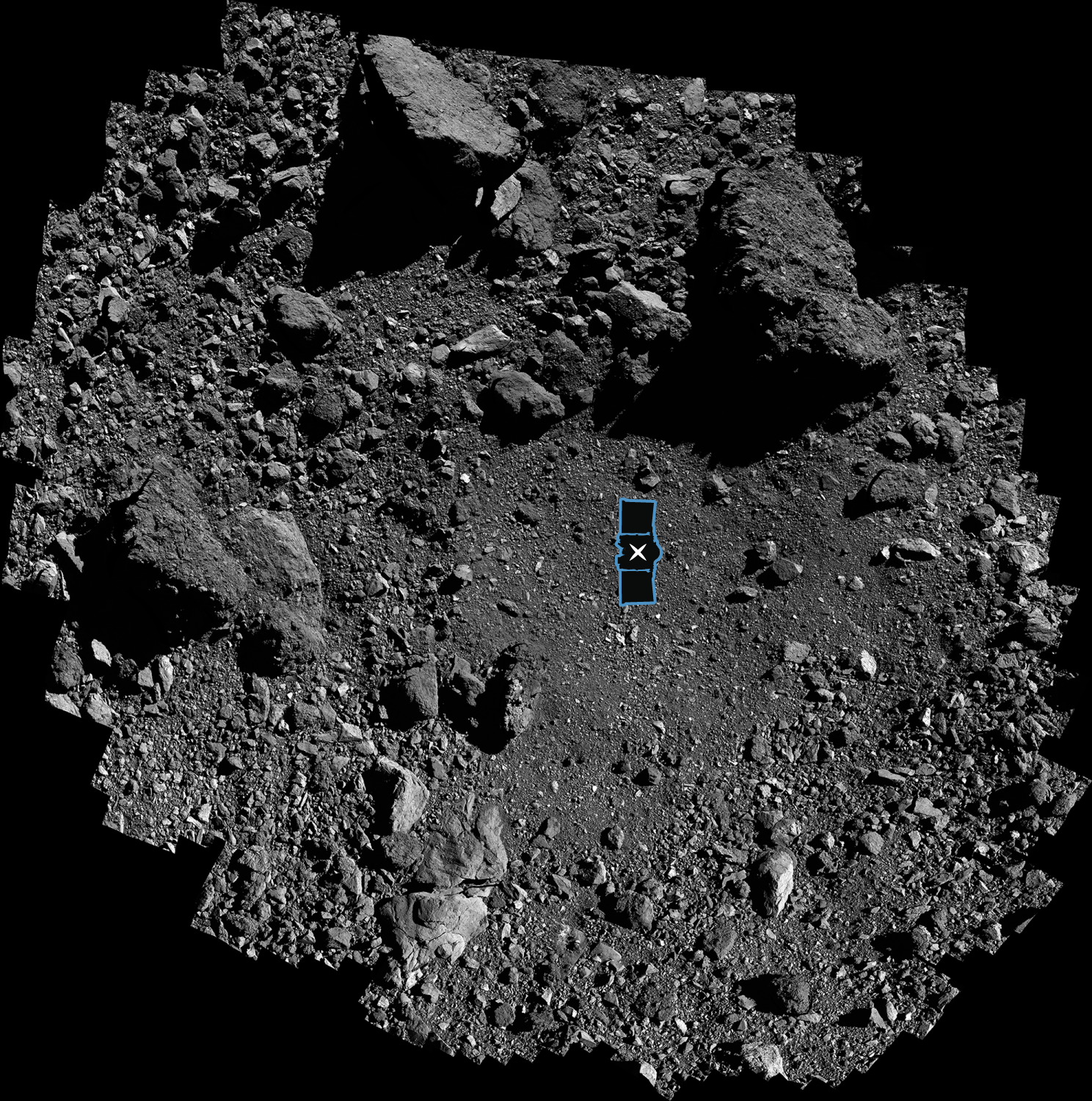
“The abundance of carbon-bearing material is a major scientific triumph for the mission. We are now optimistic that we will collect and return a sample with organic material – a central goal of the OSIRIS-REx mission,” said Dante Lauretta, OSIRIS-REx principal investigator at the University of Arizona in Tucson.
This carbon material can also give scientists insights into how much water Bennu used to have and still has now.
“Our recent studies show that organics and minerals associated with the presence of water are scattered broadly around Bennu’s surface, so any sample returned to Earth should contain these compounds and minerals,” said SwRI’s Dr. Vicky Hamilton, a coauthor on all three papers. “We will compare the sample’s relative abundances of organics, carbonates, silicates and other minerals to those in meteorites to help determine the scenarios that best explain Bennu’s surface composition.”
Some of the boulders on Bennu have been found to contain mineral veins composed of carbonate. On Earth, such carbonate minerals often precipitate from hydrothermal systems that contain both water and carbon dioxide. Some of the boulders with veins are close to the sampling site, meaning that, hopefully, the samples returned to Earth will contain some carbonate too.
“Boulders strewn about near the Nightingale site have bright carbonate veins,” Hamilton said. “Bennu shares this compositional trait with aqueously altered meteorites. This correlation suggests that at least some carbonaceous asteroids were altered by percolating water in the early Solar System.”
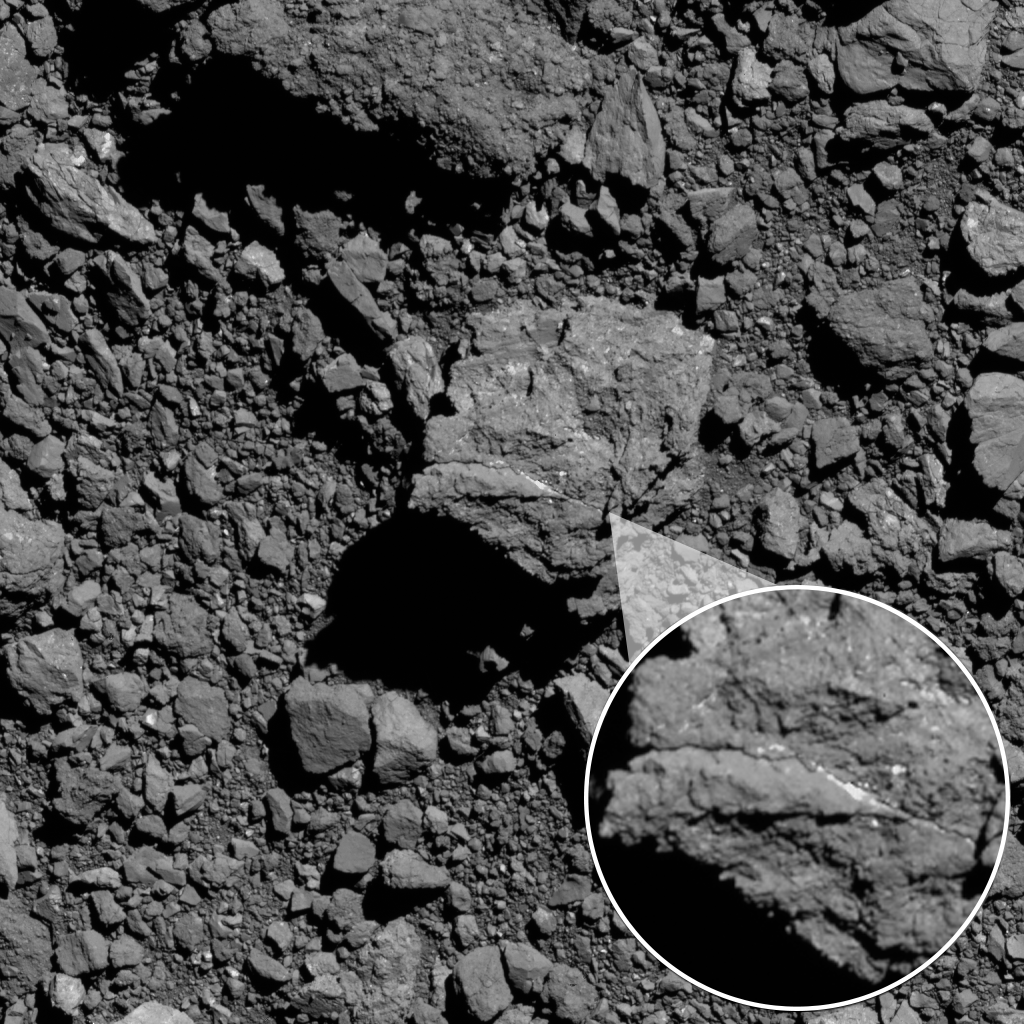
Having the samples in hand will tell scientists a lot more about Bennu’s geology, of course, but based on other data collected by OSIRIS-REx so far, researchers think that Bennu’s parent asteroid or planetary body likely had an extensive hydrothermal system. The fact that some of the veins are a few feet long and several inches thick is evidence for this.
The regolith at Nightingale is also geologically quite young and pristine. This means that it hasn’t been exposed for as long a period of time as other locations on the asteroid to the harsh space weathering environment with strong radiation (which hits Bennu’s surface since Bennu has no atmosphere).
“Bennu’s diverse surface includes abundant primitive material potentially from different depths in its parent body plus a small proportion of foreign materials from another asteroid family littered about its surface,” said SwRI’s Dr. Kevin Walsh, a coauthor of one of the papers. “In addition, both the primary and back-up sample sites, Nightingale and Osprey, are situated within small spectrally reddish craters that are thought to be more pristine, having experienced less space weathering than most of Bennu’s bluish surface.”
These findings will help scientists better understand how cosmic rays and the solar wind affect the surface of asteroids. In false-color imaging, the longer that surface material has been exposed to this kind of space weathering, the bluer it looks. The freshest material on Bennu still looks reddish, but the average on Bennu is a less intense blue color.
Another paper highlights the different kinds of boulders on Bennu; some are dark and rough, while others are brighter and smoother. The dark boulders are weaker and more porous, while the bright ones are stronger and less porous. It is also the brighter boulders that contain the mineral veins.
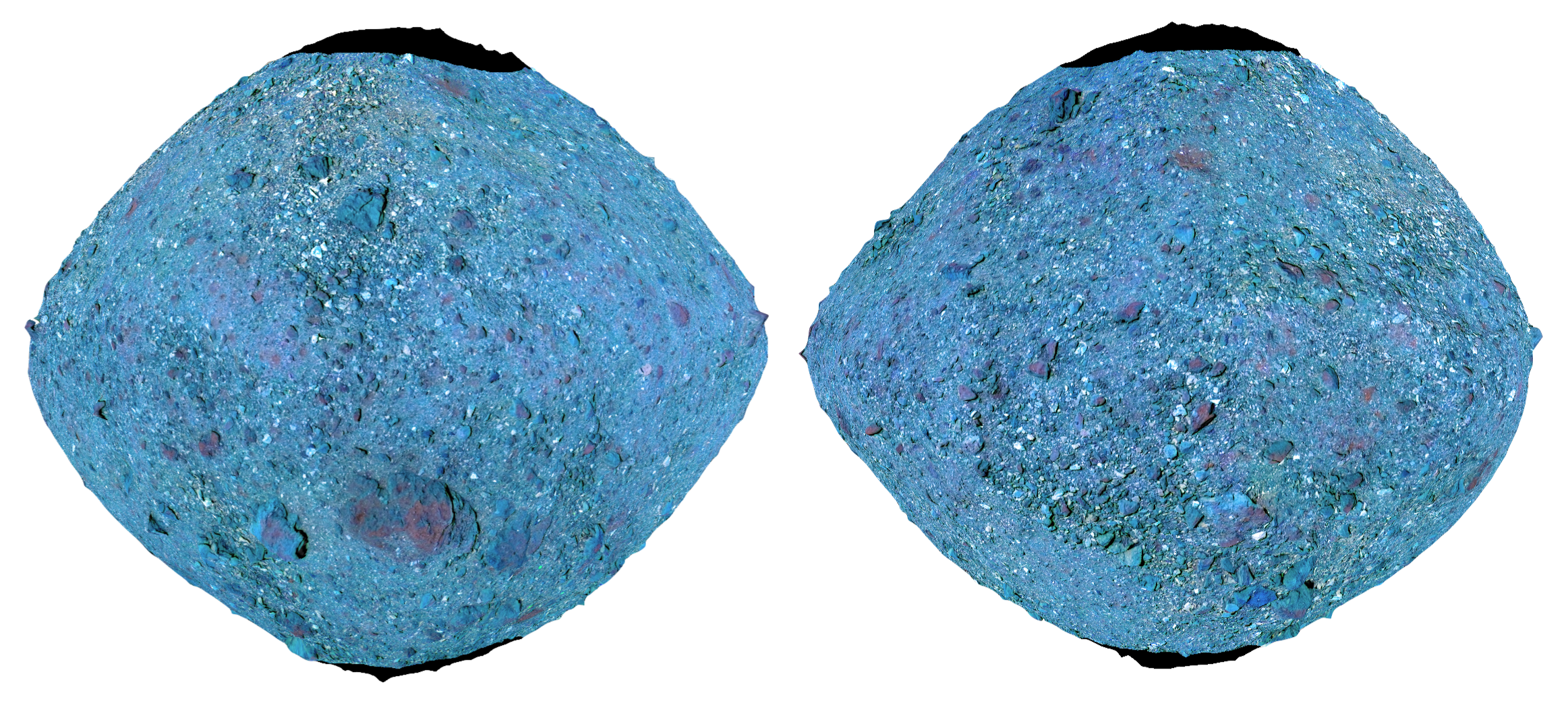
Both types of boulders are weaker than had been expected, however. That’s actually a good thing, because it means that similar types of meteorites would probably not survive the plunge through Earth’s atmosphere. That, in turn, means that the composition of the samples returned to Earth will likely be significantly different from any meteorites that have ever been collected.
One of the other papers deals with Bennu’s gravity. Scientists have been able to map the asteroid’s gravity field by analyzing its effects on the trajectories of both the spacecraft and small particles that get ejected from Bennu’s surface.
By analyzing the asteroid’s gravity field, scientists determined that Bennu’s interior is patchy. Some regions are much less dense than others, and the center is very low density, almost like there’s a big hole inside the center of Bennu. The bulge around Bennu’s equator is also less dense, and scientists think this means that material inside the asteroid is being “lofted” into the equatorial region.
Touch-And-Go (TAG) sample collection
But before those precious samples can be sent back to Earth for analysis, they have to be collected. That will be OSIRIS-REx’s mission on October 20, when the first Touch-And-Go (TAG) sample collection will be attempted. If it works, it will be the first-ever sample collection from an asteroid by any NASA mission.
Nightingale, the touchdown site for the sample-taking, is a rocky area 52 feet (16 meters) in diameter in the northern hemisphere of the asteroid. OSIRIS-REx will descend to the surface for only a few seconds, but that’s all that is needed to collect the samples. There is also a backup site called Osprey.
The entire sample collection event, including descent, sampling and ascent will last about 4.5 hours. The spacecraft will leave its orbit around Bennu when it is still 2,500 feet (770 meters) above the surface.
To obtain the rock and dust samples, OSIRIS-REx will use its robotic sampling arm, called the Touch-And-Go Sample Acquisition Mechanism (TAGSAM). The spacecraft will need to do this autonomously, since it takes about 18.5 minutes for signals to travel from Bennu back to Earth. To do this, it will use its Natural Feature Tracking (NFT) navigation system.
Navigation images will be taken 90 minutes after OSIRIS-REx leaves orbit, which are compared to an image catalog onboard the spacecraft. This helps the spacecraft maneuver to the right location on Bennu.
There is also a hazard map in the navigation system, to help OSIRIS-REx avoid large boulders.
If all goes as planned, OSIRIS-REx will collect at least 2 oz. (60 grams) of material from Bennu’s surface, to be stored for later delivery to Earth. How will the scientists know for sure that it worked? The spacecraft’s SamCam camera will capture images of the TAGSAM head to see whether it actually contains the material two days later, on October 22. The spacecraft will also perform a spin maneuver on October 24, which will let scientists know just how much material was collected.
If everything worked, the material will be stored in the Sample Return Capsule (SRC). But what happens if it didn’t work and there is too little or no material? In that case, up to two more attempts to collect the samples will be made.
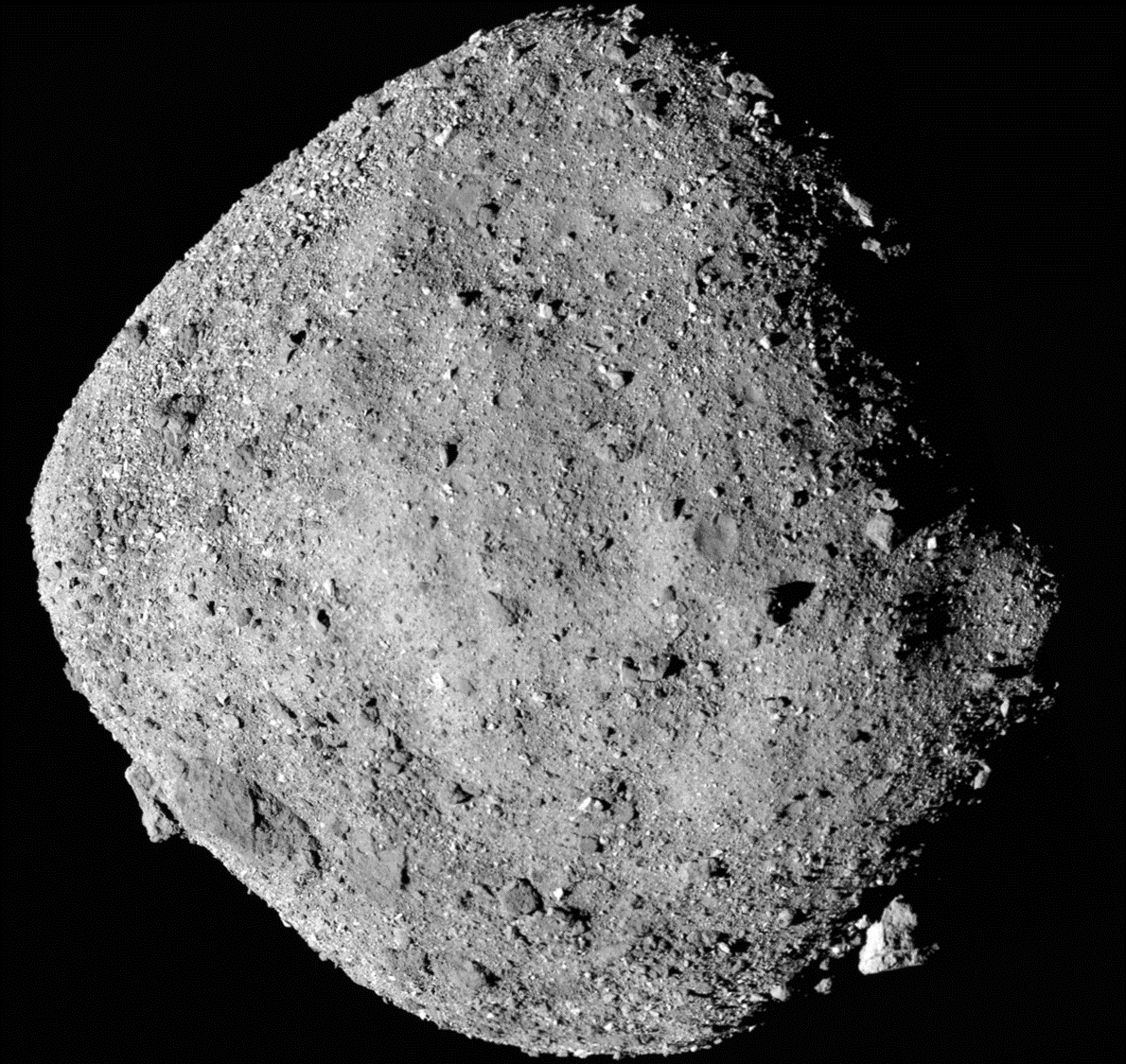
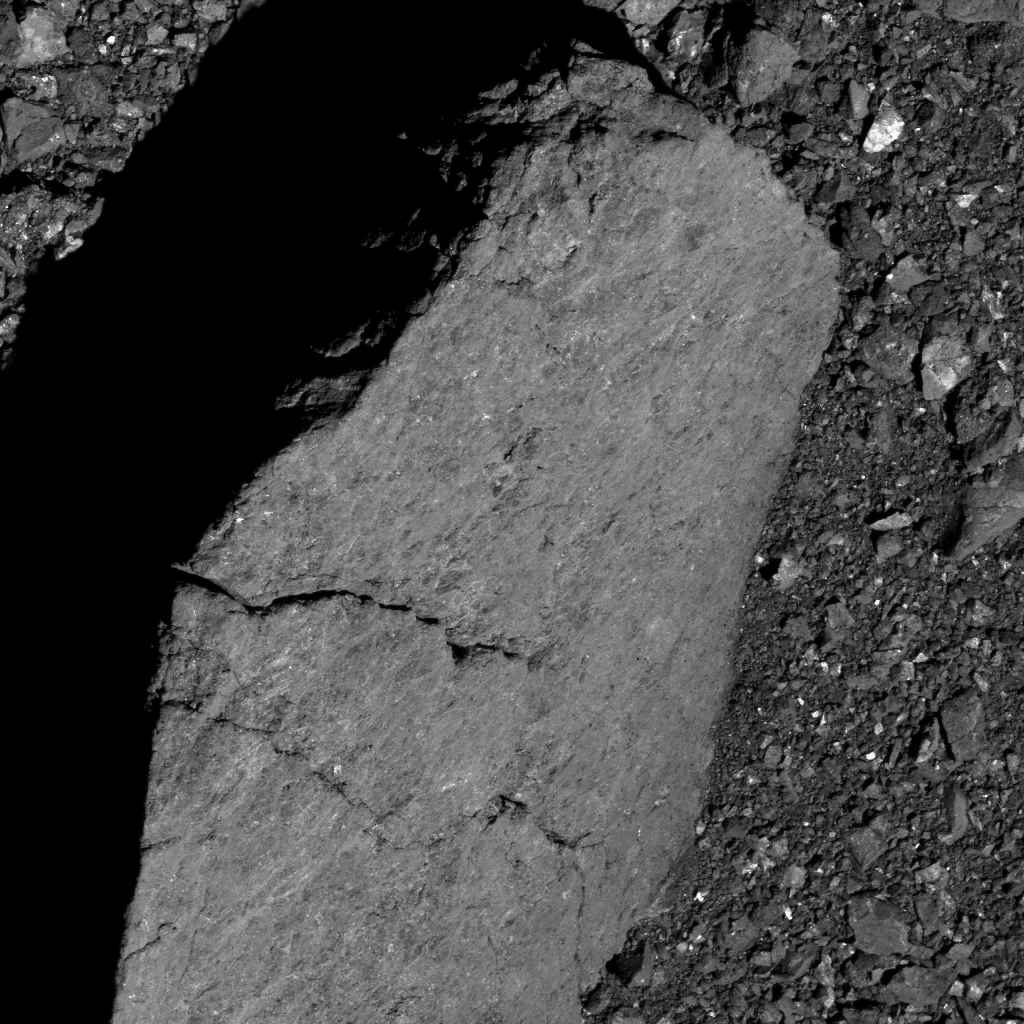
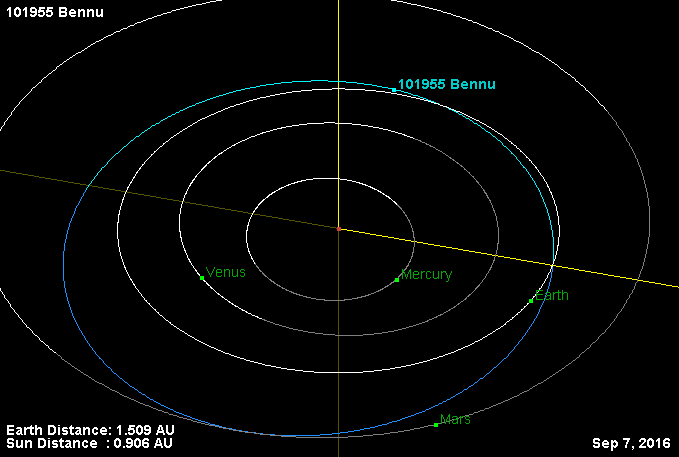
OSISIRIS-REx is scheduled to leave Bennu sometime in 2021 and will deliver the samples to Earth on September 24, 2023.
Bennu, which resides in the inner Solar System, was discovered on September 11, 1999, and is named after the Bennu, the ancient Egyptian mythological bird associated with the Sun, creation, and rebirth. It has a mean diameter of 490 meters (1,610 feet).
Bennu is classed as a near-Earth asteroid that has a cumulative 1-in-2,700 chance of impacting Earth between 2175 and 2199.
Bennu also has some similarities to another near-Earth asteroid called Ryugu. Both asteroids are thought to have originated from larger objects in primitive asteroid families within the main asteroid belt between Mars and Jupiter. The Japanese Hayabusa2 spacecraft rendezvoused with Ryugu in 2018. It studied the asteroid for a year and half before collecting its own samples. Those samples are on their way back to Earth now, and will arrive on December 6, 2020.
It will be interesting to see how the composition of those samples compares to those from Bennu. This is important, as it will help scientists better understand how asteroids like these formed and what the original parent bodies were like a few billion years ago.
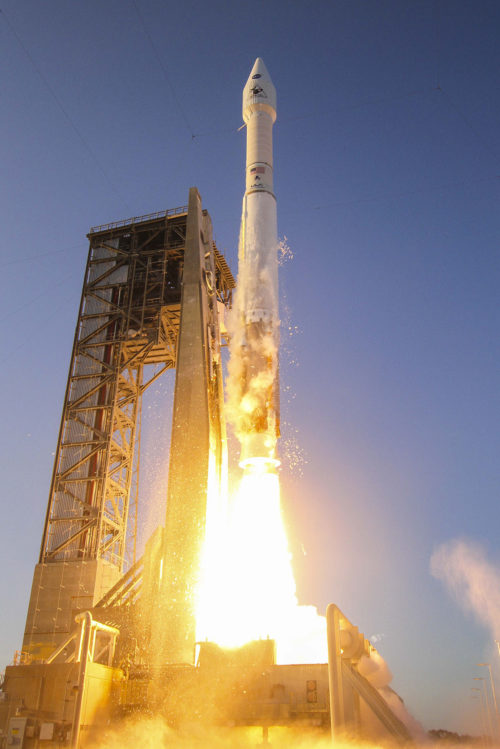
In another surprise, OSIRIS-REx also recently found some fragments of asteroid Vesta on the surface of Bennu. Six boulders were discovered that are brighter than the rest of Bennu and match material known to exist on Vesta. Vesta resides in the main asteroid belt and is the second-largest asteroid, after the dwarf planet Ceres.
“Our leading hypothesis is that Bennu inherited this material from its parent asteroid after a vestoid (a fragment from Vesta) struck the parent,” said Hannah Kaplan of NASA’s Goddard Space Flight Center in Greenbelt, Maryland. “Then, when the parent asteroid was catastrophically disrupted, a portion of its debris accumulated under its own gravity into Bennu.



